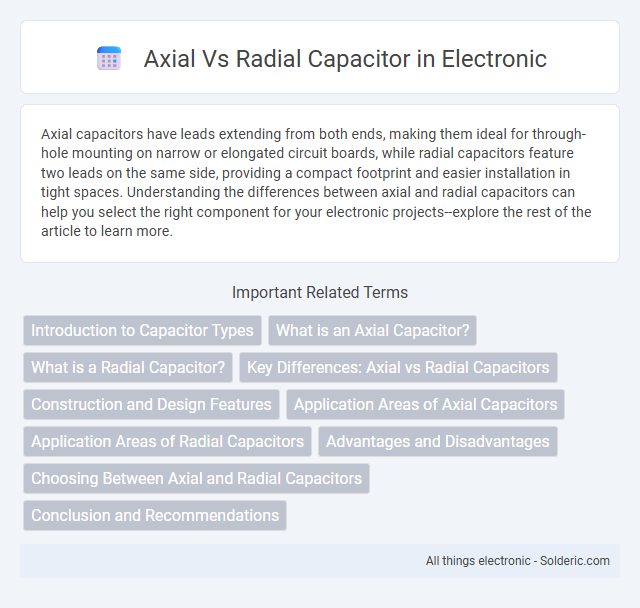Axial capacitors have leads extending from both ends, making them ideal for through-hole mounting on narrow or elongated circuit boards, while radial capacitors feature two leads on the same side, providing a compact footprint and easier installation in tight spaces. Understanding the differences between axial and radial capacitors can help you select the right component for your electronic projects--explore the rest of the article to learn more.
Comparison Table
| Aspect | Axial Capacitor | Radial Capacitor |
|---|---|---|
| Lead Configuration | Leads extend from both ends (axial) | Leads extend from one side (radial) |
| Mounting Style | Inline through-hole mounting | Compact through-hole or surface mount |
| Space Efficiency | Longer length, less compact | Shorter height, more compact |
| Applications | Wiring harnesses, electronic filters | PCB mounting, power supplies, consumer electronics |
| Voltage Ratings | Typically higher voltage ratings available | Generally lower voltage ratings than axial |
| Mechanical Stability | Good in applications with axial stress | Better suited for vibration and shock resistance |
| Cost | Moderate cost | Often lower cost due to compact design |
Introduction to Capacitor Types
Axial capacitors feature leads extending from opposite ends of a cylindrical body, offering easy mounting in linear circuit layouts, while radial capacitors have both leads emerging from one end, saving board space for compact designs. You can select axial capacitors for applications requiring robust mechanical stability and radial types for high-density circuit boards. Understanding the physical orientation and lead configuration of these capacitor types is essential for optimizing installation and performance in electronic devices.
What is an Axial Capacitor?
An axial capacitor features leads extending from each end along the component's axis, making it ideal for through-hole PCB designs requiring compact, linear installations. This capacitor type often offers improved mechanical stability and is commonly used in vintage audio equipment and power electronics. Your selection of an axial capacitor ensures reliable performance where space constraints and lead orientation are critical factors.
What is a Radial Capacitor?
A radial capacitor features leads that emerge from one end of a cylindrical body, enabling straightforward mounting on printed circuit boards (PCBs) with space-saving vertical placement. Its design typically supports higher capacitance values in a compact form, making it suitable for applications requiring efficient circuit board real estate usage. Understanding the difference between axial and radial capacitor lead configurations can help you select the right component for your electronic projects.
Key Differences: Axial vs Radial Capacitors
Axial capacitors feature leads extending from both ends of a cylindrical body, making them ideal for through-hole mounting in linear or compact circuit layouts, while radial capacitors have both leads protruding from the same side, allowing for a smaller footprint on printed circuit boards (PCBs) and easier automated assembly. Axial capacitors generally handle higher voltage ratings and are preferred in applications requiring robust mechanical stability, whereas radial capacitors often offer higher capacitance values in a more compact package suitable for dense PCB designs. The lead orientation and physical size significantly influence their selection based on circuit design, assembly methods, and electrical performance requirements.
Construction and Design Features
Axial capacitors feature leads extending from both ends along the same axis, allowing for easy insertion in narrow spaces and streamlined circuit layouts. Radial capacitors have both leads emerging from one side, providing a compact footprint that suits vertical mounting on PCBs. Understanding these construction differences helps optimize Your component choice for specific design requirements like space constraints and mounting style.
Application Areas of Axial Capacitors
Axial capacitors are widely used in applications requiring compact layouts with low profile components, such as in power supplies, audio equipment, and automotive electronics. Their axial leads facilitate easy mounting on printed circuit boards (PCBs) where space constraints or specific orientation is essential. These capacitors are particularly favored in vintage electronics restoration and industrial machinery due to their robust design and reliable performance under mechanical stress.
Application Areas of Radial Capacitors
Radial capacitors are widely used in electronic circuits where space efficiency and automated assembly are crucial, such as in power supplies, audio equipment, and lighting systems. Their compact design with leads extending from one side makes them ideal for through-hole mounting on printed circuit boards (PCBs) in industrial and consumer electronics. You will find radial capacitors commonly employed in filtering, energy storage, and signal coupling applications due to their reliability and ease of integration.
Advantages and Disadvantages
Axial capacitors offer easier mounting in linear circuit designs due to their lead configuration, making them ideal for applications with limited height clearance but require more board space for length. Radial capacitors provide a compact footprint with leads emerging from the same end, which results in denser PCB layouts and improved mechanical stability, though they may be less suitable for through-hole mounting in narrow boards. The choice between axial and radial capacitors depends on space constraints, mounting preferences, and mechanical stress considerations in the specific application.
Choosing Between Axial and Radial Capacitors
When choosing between axial and radial capacitors, consider the available PCB space and mounting orientation; axial capacitors are ideal for through-hole mounting in tight, linear spaces, while radial capacitors suit compact layouts with vertical orientation. Your decision should also factor in mechanical stability and ease of insertion during assembly, as axial leads provide better vibration resistance whereas radial leads facilitate automated placement. Selecting the right type impacts circuit reliability, performance, and manufacturing efficiency.
Conclusion and Recommendations
Axial capacitors offer compact design and ease of mounting for single-layer PCB layouts, making them ideal for space-constrained applications. Radial capacitors provide higher capacitance values and better thermal stability, suitable for high-frequency and power-intensive circuits. For general electronics, choose axial capacitors when axial lead routing is preferred; select radial capacitors for enhanced performance in densely packed or high-demand environments.
Axial vs radial capacitor Infographic

 solderic.com
solderic.com